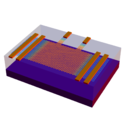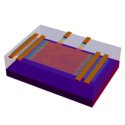Graphene asymmetries
Theorists studying the transport properties of graphene rarely have to deal with how the carbon sheet is connected to the environment. Experimentalists, on the other hand, need to carefully understand how connections to experimental apparatus affect the properties of the system they are studying.
As Benjamin Huard, Nimrod Stander, Joey Albert Sulpizio, and David Goldhaber-Gordon of Stanford University explain in a paper in Physical Review B, metallic contacts can have a marked effect leading to asymmetry in the transport of electrons and holes in graphene. They have used two kinds of metal contacts: (i) invasive, that span the whole width of the sheet and are sensitive to the properties of both the metal/graphene interface as well as those of the graphene sheet, and (ii) external, which connect to the sheet through narrow graphene side arms and are sensitive only to graphene properties. Different metals were also tried as contacts. They find that the asymmetry in conductance is caused by a transfer of charge from the metal to the graphene at the interface. A junction (like that found in diodes or transistors) with properties that depend on the type of carriers (holes or electrons) is then created.
These conclusions are important for any experiment or device using graphene and involving invasive metal contacts, as the effects reported in this work must be taken into account for the calculation of physical properties from measurements. – Alexios Klironomos





